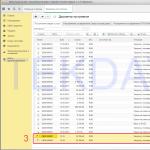Recently, various compact mobile devices have gained great popularity. electronic devices, allowing you to use all the services and entertainment of the Internet without being “tied” to a specific place - smartphones, tablets, communicators and, above all, laptops.
Of course, in order for mobile devices to be fully mobile, they must be equipped with their own power sources.
This is especially true for the most energy-consuming mobile devices– laptops. The energy source for almost all modern laptops is lithium-ion batteries.
Lithium-ion batteries have replaced nickel-cadmium batteries and have almost completely conquered the mobile device market due to a number of advantages, including:
- long service life;
- light weight;
- compact size;
- lower cost;
- short charging time;
- longer operating time on one charge;
- lower price.
However, there are certain nuances in the operation of lithium-ion batteries that must be taken into account if we want the laptop to serve us longer without replacing the battery, because the cost of a new battery can reach a third of the cost of the entire mobile computer. So, let's find out how to charge a laptop correctly.
Secrets of proper charging
Figuring out how to properly charge a laptop battery turned out to be not so easy. There are a lot of opinions on this matter. As you know, everyone knows how to play football, treat any disease and raise other people's children. Nowadays, this list of “general knowledge” can be added to the knowledge of how to charge a laptop battery.
You hear so much about this, including completely opposite opinions. For example, that the battery must certainly be charged only after it has been completely discharged, or, conversely, that the battery must in no case be allowed to discharge below a certain limit. So who should we believe?
It would seem that it would be easier to just take and read the instructions from the manufacturer, which necessarily accompanies the product. The only problem is that the instructions, as a rule, in this aspect are laconic to the point of indecentness. Sometimes information about charging is limited to the fact that for this the battery must be connected to the mains. Nothing to say, valuable information.
There is reason to think that this state of affairs is by no means accidental: income from the sale of components and spare parts can sometimes exceed the profit from the sale of the main product.
For example, we can recall an unadvertised, but by no means secret, fact: the lion’s share of the profits of printer manufacturing companies is not generated by the printers themselves. Maximum profit is derived from the sale of cartridges and consumables.
Of course, the percentage of profit from the sale of batteries relative to the total turnover is not so large, but if we're talking about about turnover in billions, then even a fraction of a percent will amount to millions and hundreds of thousands. Since we can’t count on help from manufacturers, we’ll turn to specialists for help.
- Before we talk about properly charging your laptop battery, you need to touch on general issues operation. Important for lithium-ion battery temperature regime, optimal values ambient temperature +15-25 degrees, boundary +5-45 degrees.
- Under no circumstances should you use a battery that is cooled below zero degrees Celsius. If a laptop or battery is brought in from outside, be sure to let the device warm up for at least an hour.
- When using a mobile computer at temperatures of 30 degrees or more, it is advisable to use special stands. In addition to the passive effect - providing an additional path for cooling air. Such stands can be equipped with an additional cooler, powered by battery power and connected to the device via a USB drive.
- As for how to produce charging the laptop battery correctly, here experts are almost unanimous: both those who advise completely discharging the battery and those who suggest keeping the power source constantly charged are equally mistaken.
- The optimal battery charge level is 40-80%. Maintaining the charge level within these limits can increase the service life of the element by 3-4 times, up to 1200-1500 full discharge-charge cycles.
- There are no problems with tracking the lower charge limit; all you need to do is set up the appropriate notifications. But how to catch the moment when the laptop is 80% charged? After all, even special software that limits the charge level will be useless if charging takes place in the off state (and this is exactly how it usually happens).
- There is no clear answer to this question. Some recommend using timers, for example, in mobile phone, in order to record the battery charging time and use these values in the future. Agree, this is also not the most convenient way.
- In any case, it should be taken into account that the charge level and (in particular) the remaining time until the battery is discharged, which the computer “shows” to us, may differ from reality. To clarify the picture, an operation called “ battery calibration».
- To calibrate, it is enough to continuously work on the laptop from the state of the power source " fully charged"to the state of "complete zero" (although it is better to stop at 2-3% and complete the work as usual). A full charge-discharge cycle every couple of months will not cause much harm to the battery.
- This point must be taken into account when starting to work with the device. To charge new laptop Place it correctly without turning it on, charge overnight. After this, when you turn on the device, 100% of the charge on the screen will be guaranteed to correspond to 100% in the energy storage.
- You can also use special calibration programs that, without human intervention, “drive” the computer for a couple of hours and perform a calibration.
Does this advice make any sense at all? After all, the optimal charge limits (40-80%) leave the user with less than half the possible operating time of the device, that is, depending on the tasks performed, 1.5-2.5 hours. Is there any point in mobile computer, which is capable of being mobile for a couple of hours at best?
Question: ASUS laptop does not fully charge
Hello. I'm the owner ASUS laptop x551mav-sx943b. This started recently for me (I don’t remember personally, but 3 weeks ago everything was fine). My laptop does not charge more than 89-90%. Even when the laptop is turned off, the charging diode stays on forever. I tried charging and Linux Mint, but also does not charge more than 89-90%. The laptop is only 9 months old.
Answer: Well, if such a program is installed, then the laptop will still be turned on or off, it will not charge completely
Question: Laptop won't charge
Hello.
laptop samsung np350v5c.
charger - ginzzu ga-10120u.
Yesterday, after finishing work, I turned off the laptop.
The next time I tried to turn on the laptop, it would not turn on and the battery charge indicator would not light up.
I tried to start it by removing the battery, but there was no reaction.
The same charger charges other laptops, what could be the reason?
Answer: Since the power supply is working, then it’s logical that there’s a problem with the laptop, since there’s no charge indication, it means either the power from the power supply isn’t getting to where it needs to be, maybe the firmware has crashed, and there won’t be any indication either.
Question: How to charge a laptop if the power controller has failed
I rummaged around in the laptop, poked at the power settings and stumbled on it. That the battery has stopped charging. I thought it was a charging issue. I couldn’t check the charging right away, I checked it three days later, by this time the battery charge had run out, but the charging turned out to be working. I think I disabled something in the settings. . But how can this be done if the laptop is not charging?
P.S. - please don’t troll😅
Answer:
Quote:
It doesn't happen like that.
Question: laptop. Charges only when turned off
dell xps 14z (Compal LA-7451P)
The used motherboard came from AliExpress. I immediately flashed the BIOS on the A6, but didn’t pay attention to how it behaved on the A2.
When the OS is loaded (it doesn’t matter which one. I tried Win8.1 and Ubuntu) when connecting the power cable, the charging icon blinks for about 20 seconds (battery is full) and says “connected, charging.” then the icon just lights up, at one level (how many at the moment charge), the inscription is the same, the charge does not increase. The battery does not charge or discharge. stands on the same level. turn off the laptop. then the battery is charged.
Three tips from Google did not change the situation.
Answer: oops. began to charge. in 15 minutes by 7% (even though the icon does not blink)
Question: DELL laptop won't charge
Eat Dell laptop vostro 1500/ I lost my original power supply and bought a universal one. When connecting, a message appears:
"Power Adapter not recognized."
"The AC power adapter type cannot be determined. Your system will operate slower and the battery will not charge. Please connect a Dell 90W AC adapter or higher for best system operation."
The laptop shows that power is connected, but the battery is not charging. The BIOS also states that the charger is not recognized. AcmePower ULA-12 power supply is used.
Characteristics of the native power adapter:
90W
Input: 100-240v, 1.5A
Output: 19.5v, 4.62A
Characteristics of the universal power supply:
120W
Input: same
Output: 20v (compatible with 19.5), 5A.
How can I solve the problem with charging the battery?
Answer: Specialized
A little background is needed here. If the original adapter did not burn out, but simply frayed the cord near the connector (assume 19V got to the port), or repairing the mat will help out. boards or “unlearned” from the original BIOS adapter.
For advanced users, the battery can be charged outside of the laptop.
Question: HP dv6 3123er - Laptop does not charge immediately
Laptop HP dv6 3123er win7 x64
I bought a new battery.
The laptop turns on with and without the battery (from charging)
If the battery is inserted and the charger is connected, for example, the laptop has been left for a couple of hours and I turn it on, then the charging indicator shows that the laptop is running on battery power (although the charger is plugged in).
I do 2-3 reboots and the indicator already shows that the laptop is working from the network.
What's the problem?
Thanks in advance
Answer:
Message from blrspy
he's still working
It works and disappears at the same time. Really multitasking...
Message from blrspy
MB drivers need to be reinstalled in some order, etc.?
Drivers can be installed if the device is available. And if it’s not there, it’s logical that it’s not about them.
Message from blrspy
Is it worth ordering this chip from China?
To use as a keychain? Why not?
You need to take the device to a service center, and not engage in amateur activities.
Question: Does the laptop charge if it is turned off?
Good afternoon
If the laptop is turned off. But the cord is plugged into the laptop and into the network. Is it charging or not?
Or only when I turn on the start button only then does it charge?
Thank you
Answer: Thank you
Question: The laptop does not charge and does not work from mains power (without battery) - Acer Aspire 5720G
Yesterday I was sitting at my laptop and suddenly the brightness dropped to 50%. I looked in the lower right corner, and there was a “battery” icon instead of “charging”. The laptop operation indicator is on the left (green, as in the picture), charging indicator is on the right (yellow when charging, green - the battery is charged). The charging indicator does not light up. I thought the electricity had been turned off.
I look at mine electronic watch in the room - they are working! I checked the cable from the power supply - it is connected. I decided to turn it off and unplug it. The laptop is turned off. I connect the charger - the “charging” indicator blinks (it was always on, not blinking), but there is no time dependence. Blinks randomly yellow. It might blink 2 times in a second, or maybe once in 5 seconds... I heard from a friend that his battery was dead and then he took out the battery and connected it directly to the power supply and the laptop started from the network. I also pulled out the battery. Connected the power supply. I try to launch it - it doesn't work. I decided to rest for an hour. An hour later I inserted the battery, connected it to the power supply - charging began. I started the laptop. Everything is fine. After 2-3 hours it happened again. 12 hours have passed since then and nothing helps. The power supply looks intact from the outside. The green indicator on the power supply is on as usual. It feels like there is something inside the laptop... The laptop starts with the battery (which has about 3-4 minutes of charge left), but does not want to charge. I do not accept SC and other similar answers. If something specifically needs to be replaced, then write so. Thank you
You insert the plug and it charges for 10 seconds and then stops, the indicators start flashing.
You take it out - everything works. That is, the laptop works stably from the battery, as soon as you connect the charger such a problem begins. I started the laptop without a battery on one power supply unit, everything starts up and works, but it can stop working at any moment. Off - charging normally. And I also noticed that if you insert the charger, start it, load Windows and do nothing else, then the charging goes on and nothing blinks, but as soon as you start launching programs or opening windows - again after 10 seconds. begins...
PSU 90W 19B x 4.74A (measured output voltage 19.45 V)
Battery 4400 mAh wear 57% (lasts about an hour).
Laptop: Acer Aspire 5552G
Answer: I was at the service center.
After diagnostics, the cause of the failure was revealed:
"The contacts of the cable that goes from the charging socket (controller) to motherboard" Because of which they burned, they said it was not connected tightly, because of this, 2 middle contacts + and - were broken, but the outer ones remained intact. I had to change this wire with contacts and the power socket.
Total: 1 day of work and 1680 rubles for working with parts.
Without batteries, no electronics will work - from laptops to regular MP3 players. In recent years, lithium-ion batteries, designated Li-Ion, have become the most common. At large capacity they are relatively light in weight. Their only drawback is the need to follow some rules. For example, you need to know how to properly charge a laptop so as not to damage the battery by sharply reducing its capacity.
Make sure your computer actually has a lithium-ion battery. You can find out from the user manual, or simply by taking it out of the laptop and reading its specifications. If the abbreviation Li-Ion appears there, then everything is in order.
More often laptop computers They are sold with partially charged or even completely discharged batteries. And you should know exactly how to charge a laptop for the first time. Therefore, read the instructions below and calmly get to work.
Without turning on the PC, insert the plug charger into the nest. For the first time, it is better to charge it for 6-8 hours. In this case, you will definitely receive a battery that is charged to 100 percent capacity. If you charge the PC while the PC is on, then after 15-20 minutes the icon will show full charge– of course, this is a small mistake. In this case, you can turn off the computer, remove the battery, and wait a few seconds. After this, reinsert the battery and continue charging with the computer turned off. Don't be surprised if your laptop gets very hot while charging.
If you want the battery of your device to have maximum capacity (and therefore allow it to work without recharging for as long as possible), it needs to be “trained”. To do this, when the battery is fully charged in 6-8 hours, disconnect the power supply and start working in offline mode. When the battery is completely discharged, charge the PC again, preferably overnight. By repeating a similar cycle 3-4 times, you can develop the battery to its maximum - now it will reach maximum capacity and it will be for a long time save it.
Please note that during the first few weeks of use, the battery may charge and discharge much faster than specified. Therefore, constantly monitor the indicators so as not to lose the data that is important to you. Also, don't grab your laptop and run to the computer store blaming the salespeople for what they sold you poor quality product. After a few weeks of use, if you have properly charged and discharged the battery, everything will return to normal. And now the laptop will surely become your faithful companion on any trip for a long time.
Is it possible to turn off the laptop while charging the battery?
I periodically charge the battery (i.e. the laptop battery), while keeping the laptop plugged in. And the question is ripe: is it possible to turn off the laptop while charging the battery? Will the battery be charged? Will it get damaged with this charging method?
Paul03-17 | 10 March 2017, 15:14
The question is formulated somewhat strangely. However, I will try to answer. The laptop battery is charged from a household electrical network. This is possible regardless of whether the laptop is running. It is enough just to keep the laptop connected to a household electrical network with the battery. Charging is performed in the same way as if the laptop was active. The microcontroller on the battery itself protects the battery from overcharging, so this method is safe.
Alek55sandr5 | March 21, 2016, 02:25
Yes, you can turn off your laptop while it is charging. The battery will charge in the same way as when the laptop is turned on. But it will happen a little faster because the laptop doesn't drain battery power when it's off. And nothing will get spoiled. I also note that the charge of the laptop is indicated by an indicator (light bulb). If the indicator is red, it means that the battery is charging, if the indicator is green, the battery is charged.
Nikolay | January 11, 2013, 10:11 pm
The laptop itself can be turned off. However network adapter must be connected to the laptop and from the other end to the network.
Wostok | 11 January 2013, 20:08
If you disconnect from the network, where will the energy come from? You can shut down the device (TURN OFF) without unplugging it and everything will charge. Nothing bad will happen, this is the normal operating mode of the battery during any manipulation of the power supply!
Laptops have long become an indispensable attribute of every modern person - a pass to the magical world of the Internet. We use them to work, play and communicate from anywhere on the planet. And if you're like most people, keep your laptop plugged in at home and at work. But in vain.
If you want to squeeze maximum energy out of your laptop's batteries, unplug it as soon as the indicator shows 100 percent charge. And even a little earlier.
The head of Cadex Electronics, Isidor Buschmann, is confident that ideally you need to charge the battery to 80 percent, then turn it off, wait until the charge level drops to 40 percent, and turn it on again. This technique will extend the life of your battery up to four times.
The reason lies in the voltage level of each element of the lithium polymer battery. The higher the charging percentage, the higher the voltage level. The higher the voltage level, the higher the load on each element. This load results in a reduction in discharge time. According to the Battery University website, if a laptop can produce 300-500 discharge cycles when charging to 100 percent, then when charging to 70 percent, the number of these cycles increases to 1200-2000.
Buschmann knows this well, as his company sponsors Battery University. In addition, he claims that it is not only constant connection to the network that shortens the life of the battery - temperature also plays a significant role in this process. Overheating can cause battery cells to expand and cause bubbles to form. Such a battery will not last long.
To avoid these troubles, it is better not to close the laptop lid or keep it on your lap.
Buschmann admits that his advice to keep charge levels between 40 and 80 percent is easier said than done. Constantly keeping the indicator under control during operation is not very convenient. “But it’s not that hard to at least charge it to about 80 percent every time. And when you're going on a trip, stop charging a little short of 100 percent,” he says.
Some users have adapted to calculating the time it takes the computer to discharge from 80 to 40 percent and set a timer. They do the same thing over time as the batteries charge.
A complete discharge and charging cycle of the battery makes it possible to calibrate the device. This procedure must be carried out once a month. Only in this case, after a large number of incomplete charges, will it be possible to count on correct and correct work functions to indicate the exact time remaining until the laptop is completely discharged.
It is also worth noting that lithium ion batteries On average they last about three years. After this, it would be advisable to replace the battery with a new one. Therefore, you should not fanatically follow recommendations on how to extend the life of your laptop battery. First of all, you should use the laptop in a way that is convenient for you. That is, fully charge the battery before the trip, and do not panic when the battery is completely discharged. Follow the recommendations given if possible.




